Jake Munroe, Mike Cowbrough and Sebastian Belliard (OMAFRA)
Cereal rye (Secale cereale) has several strengths as a cover crop option. It’s relatively inexpensive and easy to kill. Rye improves soil structure, builds organic matter and helps protect against water and wind erosion. It can suppress weeds as discussed here (see Figure 1). It’s also very winter hardy and often the only cover crop option to seed after grain corn or soybeans. However, in most cases, rye doesn’t put on much growth until the month of May.
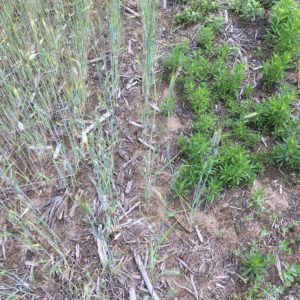
Spring termination decisions
Delaying termination up until soybean planting provides an opportunity to enhance rye’s benefits by giving it more time to grow in the spring. The question is, does planting soybeans “green” into living rye negatively impact yield? This was the motivation for a series of on-farm trials from 2017 to 2019, in which soybeans grown after early-terminated rye were compared to those “planted green” into rye.
There were two main treatments: early rye termination (two weeks before soybean planting) and late termination (day of planting, also referred to as “Plant Green”). Trials in 2019 also had a no-rye control treatment. Sites had 2-6 randomized replicates of each treatment. Background site information is provided in Table 1.
Table 1. Site descriptions and cereal rye seeding details of trial locations
| Site | Soil type | Previous crop | Rye seeding date | Rye seeding rate (lbs/ac) | Seeding method |
| St. George 2017 | Beverly silt loam | Grain corn | Nov. 4, 2016 | 35 | Broadcast + incorporated with minimum tillage |
| Brantford 2018 | Brantford silty clay loam | Silage corn | Oct. 20, 2017 | 90 | Drilled |
| St. George 2018 | Brantford silty clay loam | Soybean | Oct. 23, 2017 | 37 | Drilled |
| Lambton 2018 | Perth clay | Soybean | Late Aug., 2017 | 20 | Interseeded in standing soybeans |
| Elora 2019 A | London loam | Silage corn | Sept. 24, 2018 | 30 | Drilled |
| Elora 2019 B | London loam | Silage corn | Sept. 24, 2018 | 60 | Drilled |
| Kenilworth 2019 | Perth silt loam | Silage corn | Oct. 26, 2018 | 40 | Drilled |
| Wroxeter 2019 | Perth silt loam | Grain corn | Oct. 31, 2018 | 100 | Broadcast |
| Winchester 2019 | North Gower clay loam | Silage corn | Sept. 21, 2018 | 50 | Drilled |
| Morrisburg 2019 | Morrisburg clay loam | Grain corn | Sept. 22, 2018 | 65 | Broadcast interseeded in standing corn |
| Newington 2019 | Grenville loam | Grain corn | Oct. 25, 2018 | 80 | Drilled |
Rye growth accelerates in May
Across 10 sites, rye biomass increased on average by 3-times – from 500 lbs/acre to 1,500 lbs/acre – when terminated at time of soybean planting compared to ~2 weeks prior. At the Kenilworth 2019 site, biomass increased by nearly 10-times when termination was delayed until planting (Figures 2 and 3). Extra biomass contributes to soil organic matter, soil structure and provides a longer-lasting mulch.

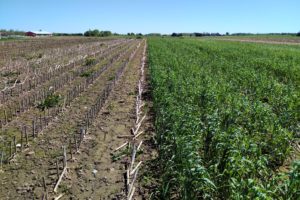
Planting green can impact soybean stand and crop development
Delayed termination of rye does not come without risk. Soybeans stands were reduced at some sites. On average, soybean stands across 7 sites were reduced by 14% when planted green. Two sites in 2018 had stands less than 100,000 plants/acre due to planting into thick rye at a relatively low seeding rate (140,000).
When planting green into a moderate or thick stand of rye, a minimum soybean seeding rate of 160,000 seeds/acre is recommended. It’s also particularly important to plant into moisture and ensure that the seed trench is closed.
There was no difference in soybean development between no rye strips and early termination strips in 2019. Soybeans in late-terminated, higher biomass rye, however, tended to have delayed development. At the Brantford, Lambton and Elora sites, plants were consistently one growth stage behind in the “plant green” plots relative to the early termination strips (Figures 4 and 5).
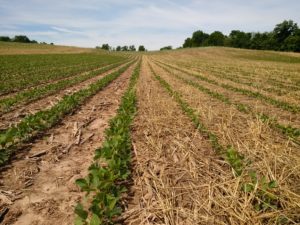
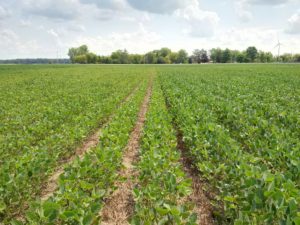
Weed effects
Effects of rye and rye termination were evaluated at five trial sites in 2019. Visual differences in weed abundance were minimal at the on-farm sites. However, at the Elora Research Station, where there was high weed abundance, visual differences amongst treatments were more obvious, with later termination of rye having the least amount of weeds (see Figure 6).

Overall, there was a trend towards lower weed abundance at the beginning of the critical weed-free period in soybean (V1) planted into the cereal rye treatments (five sites, 2019). Weed abundance was the lowest in the late termination treatments (Figure 7), which is predictable given that rye termination with glyphosate was applied later than the other treatments.
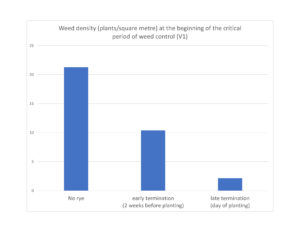
It should be noted that weed abundance was high enough in all treatments to negatively affect yield if not controlled, so cereal rye is not going to replace other methods of weed control; however, it can be a tool to improve the performance of other weed control methods simply because they don’t have to control as many weeds.
Yield results
In 9 out of 10 trials, there was no difference in soybean yield regardless of when rye was terminated (Table 2). There was a significant difference in yield at the Elora site in 2019, and this was primarily due to plant stand damage caused by roller crimper activity in wet conditions on the small plots. Otherwise, yields between early and late terminated rye treatments did not differ.
Table 2. Summarized yield results (based on 13% moisture). Statistically significant differences in yield amongst treatments at each site are shown by different letters.
| Site | Yield (bu/acre) | ||
| No Rye (Control) | Early Termination | Late Termination | |
| St. George 2017 | – | 57.0 A | 60.2 A |
| Brantford 2018 | – | 51.3 A | 50.0 A |
| St. George 2018 | – | 69.5 A | 66.7 A |
| Lambton 2018 | – | 63.1 A | 58.6 A |
| Elora 2019 AB* | 46.8 A | 42.9 A | 33.4 B |
| Kenilworth 2019 | 54.7 A | 54.9 A | 54.7 A |
| Wroxeter 2019 | 52.6 A | 51.4 A | 51.8 A |
| Winchester 2019 | 49.3 A | 46.2 A | 47.8 A |
| Morrisburg 2019 | 48.7 A | 48.4 A | 48.1 A |
| Newington 2019 | – | 44.5 A | 43.2 A |
| Average | – | 52.9 | 51.5 |
* Yield data combined for Elora 2019 A and B due to limited plot length
Making sense of the numbers
Delaying termination of rye until soybean planting carries some risk. However, across three growing seasons and at ten different sites, there was generally no yield effect– to delaying rye termination prior to soybean planting.
The following lessons have been learned so far:
- When planting green into rye, consider a higher seeding rate (e.g. 160,000 seeds/acre minimum) to minimize yield lag due to a thin soybean stand
- Pay close attention to seeding depth, since rye can create drier soil conditions
- When seeding into thick rye, ensure good slot closure and consider the impact of delayed soybean maturity on harvest timing, especially if you plan to seed winter wheat after soybeans
- Be flexible – if conditions turn dry in May, consider early termination
Putting it together
Allowing an extra couple weeks of growth maximizes the soil benefits of a rye cover crop: more biomass, more time with active roots and a lasting mulch. There may also be some weed suppression benefits. It’s a new practice, however, and still needs some fine-tuning.
If you’re new to rye as a cover crop, gain confidence by terminating it a couple of weeks before planting soybeans in the spring. If you’re more experienced, leave a couple strips to be sprayed after soybean planting this coming spring and see how it works on your farm. Have a goal in mind – is it weed management, building organic matter or overall soil health? And finally, be flexible and adapt your plans according to weather conditions.
|
“Planting soybeans green into rye is an opportunity to have a green cover from fall harvest to spring planting. It helps with erosion control, builds organic matter and may help with weed suppression.” Owen McIntyre, farmer cooperator, Brant County |
One more year of research to come
The final year of this on-farm project will take place in 2020 – check back in next year for the full set of results.
Acknowledgements
This project was supported by OSCIA Tier 1 and Tier 2 project funding. Donations of cereal rye seed were generously made by Cribit Seeds and Centre de Criblage de Marc Bercier in 2019. Thank you to all the farmer cooperators who participated.
For the full project report, check OSCIA’s Crop Advances webpage.
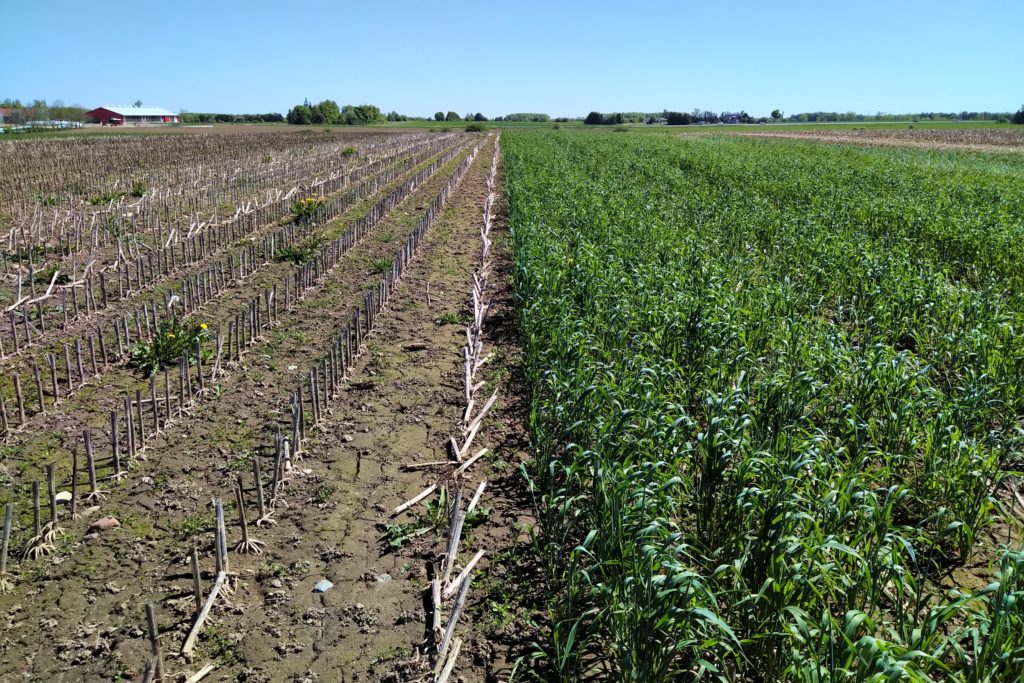
Comments are closed.